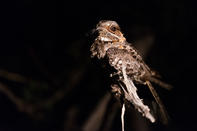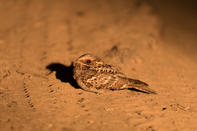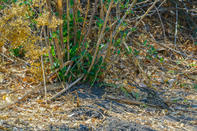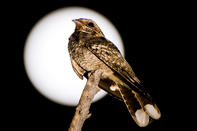
Nightjars are the superbly adapted swallows of the night. They are often spotted sitting on roads just after sundown. From here they can clearly see insects against the open sky above them and they will fly up to hawk these returning to the ground between bouts.
Most insectivorous birds have tweezer-like bills to snap up their invertebrate prey. Nightjars have very short squat bills but the design is equally ingenious. They have exceptionally wide gapes (the extent the bill is able to open) and on approach of an insect, the nightjar will open its mouth creating a veritable ‘black hole’ into which the insect is sucked.
To facilitate capturing insects in flight, nightjars have special modified sensory feathers on the face called rictal bristles. These help to channel food into the wide gape.
Nightjars are built for aerodynamics. They have narrow, flat wings that taper at the tips which facilitate the fast flight needed to catch insects on the wing. They rely on flapping to give them the momentum and lift they require to forage.
Birds with such an aerodynamic shape are also best suited to migration. Most nightjar species migrate during the autumn when their aerial invertebrate prey begins to diminish to levels that wouldn’t sustain the population through winter.
Good Night Vision

The large eyes of a nightjar are there to effect good night vision, allowing the maximum amount of light to enter the eye socket in low light conditions. Because they are so large, their shiny eyes are conspicuous by day and nightjars will close their eyes to escape detection when resting up, incubating eggs or if threatened.
The reflective layer of cells found behind the retina in these birds’ eyes assists with improved nocturnal vision. This shines red in the headlights of an approaching vehicle making nightjars easy to spot after dark.
Well Camouflaged

Nightjars have exquisitely well developed cryptic colouration, their mottled brown patterns merging them perfectly into the leafy litter of the bushveld understorey. During the day it is extremely difficult to find nightjars as they sit unmoving and rely on their crypsis to keep them concealed. So good is the nightjar’s camouflage that it does not need to produce cryptically-coloured eggs as many other ground-nesting birds do.
They will lay pale and even sometimes pure white eggs and then rely on their own body camouflage to conceal them.
The eggs are laid directly on the bare ground as any form of nesting material would compromise their camouflage.
The female incubates by day and the male relieves her by night. Should any disturbance threaten the incubating bird, it will flatten its body, eyes closed to eliminate the give-away shininess, reducing its own tell-tale shadow.
A Special Comb

Nightjars have a specially adapted preening apparatus known as a pecten or pectinate claw. The pecten is a comb device attached to the middle claw of both its feet. It is used in preening and scratching, to remove parasites or to straighten out the rictal bristles.
Hard to Tell Apart
Nightjar species are very difficult to distinguish between, all of them having similar cryptic colouration. They do vary slightly in features such as the amount of white on the tail feathers but the most reliable way of discerning between species is to use their calls.
The most iconic of African night sounds is the ‘Good Lord deliver us…’ chant of the Fiery-necked Nightjar. The sound of the Square-tailed nightjar is also a common nighttime sound in the Lowveld. It is a protracted purring noise made at different pitches and sounds a little like a small engine changing gears.
The nightjar genus Caprimulagus means ‘milker of goats’ which follows the old myth that nightjars could and would suck milk from goats.
By Megan Emmet